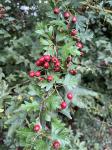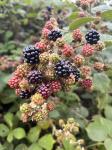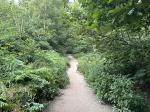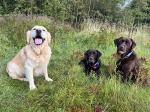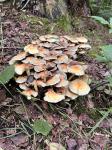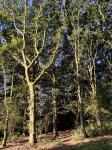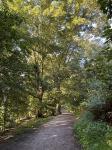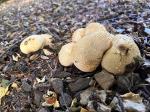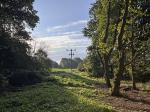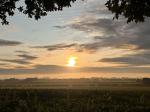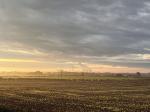Brayton Barff Through the Seasons.
Set in the Vale of York, South West of the market town of Selby and between the villages of Thorpe Willoughby and Brayton, lies Brayton Barff, a sandstone Hill approximately one hundred and fifty feet in height which was formed by glacial movement during the last Ice Age. It is a significant landmark in an otherwise flat landscape.
Today the site is primarily owned by Yorkshire Water with Selby District Council owning a small patch of the land adjacent to the A63 Selby bypass. A large underground reservoir occupies the centre of the site which delivers water to around 4.7 million customers throughout Yorkshire.
Within the Barff woodland over 40% of the trees are Sessile Oak which are generally found in semi natural woodlands in the north of the country. These trees are so called because its acorns are not held on stalks, like those of the English Oak (Pedunculate), but attached directly to the outer twigs. There are also several English Oak trees as well as some cross-hybrid oaks. These trees are known to support many species of flora and fauna, invertebrates, mosses, lichen and fungi.
During the Victorian times it is thought that the shipbuilders on the east coast would come over to the Barff for selected cuts of timber to build their sea going vessels.
The Barff also has a variety of other trees including Silver Birch, Beech, Sycamore, Holly, Rowan, Scots Pine, Alder, Hawthorne and European Larch. There are also several Yew, Willow, Hazel, Horse Chestnut and Wych Elm. As with similar woodlands there are a variety of bushes, including Honeysuckle, Elderberry, Gorse, Broom and Buddleia.
The history of Brayton Barff is quite vague, apparently during 1803 a beacon was lit on the Barff when the country was threatened with an invasion by Napoleon. In May 1935, to celebrate King George V's Silver Jubilee, a Bonfire was lit on the Barff as part of the celebrations.
Early issues of Ordnance Survey Maps dated 1903 clearly show a rifle range on the Barff, extending out to Mill Lane. During the 
Between 2001 – 2004 the A63 Selby bypass, 10km twin lane single carriageway was constructed which severed the South West corner of the Barff, adjacent to Selby Golf Course and resulted in a slight redesign of several holes on the golf course. Wooden fencing was erected as a result of this new road running alongside of the Barff and a footbridge constructed over the ‘new road’ following the line of the Bridal way which extends from Mill Lane. Around 2005/2006 a definite 2metre wide limestone aggregate footpath was laid forming a circular path around the outer edges of the woodland. This footpath is approximately 1.2 miles in length and takes about 30 minutes to circumnavigate at a leisurely pace.
In 2012 the Barff was declared an Ancient Oak Woodland and as such throughout 2012 and 2013 significant work had been carried out by the relevant agencies to cut and remove large swathes of non-native trees, creating at that time huge scars on the landscape. Some three years later the planting of the native trees have become well established and are flourishing. Ongoing maintenance work on the footpath around the bottom of the Barff was completed during the Summer of 2016.
A second phase of woodland maintenance commenced during the Autumn of 2019 with the removal of many old and diseased trees and the cutting back of the Gorse and Broom bushes, especially adjacent to the ‘bypass trail’, this work continued through till March 2020 with re planting continuing into April 2020.
Brayton Barff is a popular site for walkers and bird watchers alike and a path circling the outer perimeter of the Barff makes a pleasant thirty minute walk, giving views looking over towards Selby and the village of Brayton as well as the power stations of Drax and Eggborough..jpg)
For the early risers it is a great place to see some stunning sunrises over the villages of Brayton looking towards Drax Power Station, the same with the Sunsets looking over towards Eggborough and Monk Fryston.
The Barff changes with the Seasons and every visit can reveal something new, the woodland is a haven for wildlife. Records show that since 1982 one hundred and twelve species of bird have been seen in the woodland and at least 40 of those have bred here, including Tawny Owl, Buzzard, Green Woodpecker, Spotted Flycatcher, Goldcrest and Nuthatch to name just a few. On average over 70 species of bird are recorded each year. Further details of the bird life on the Barff can be found on the Brayton Barff Group Facebook page, especially the posts from Derek Cooper. Today ‘The Friends of Brayton Barff group’ led by Derek and a small team of volunteers help keep and maintain the cleanliness of the site as well as recording the wildlife and bird sightings.
The Barff is also home to fifteen different species of mammals, including Muntjac Deer, Pipistrelle Bat, Fox, and Field Vole.
Over eighty species of plant and wildflowers have been recorded, included Bee Orchid, Northern Marsh Orchid, Wood Anemone, Marsh Ragwort, Bluebell, White Bluebell, Bittersweet and Purple and White Foxgloves. Over twenty species of Butterfly have been recorded, including Marbled White, Brown Angus, Speckled Wood, Comma and Brimstone.
During the Autumnal months fungi thrives in this woodland environment, species including Fly Agaric, Beefsteak Tree Fungi, Chicken of the Wood, Sulphur Tufts, Stinkhorn, Ink cap, Puffballs and Hoof Bracket are just some of the many varieties that can be found here.
Click on the galleries shown below to expand the albums.
August 2023
The heavy rain in July continues into August, on Tuesday 2nd August it rained for 24 hours and dropped over 40mm of rain on our part of the county, more than a month’s supply in 24 hours. The Barff is looking quite sodden. Fortunately, the rain eased somewhat overnight, and Thursday 3rd began bright and sunny with a cooling 12C northerly breeze, though late evening we had a massive storm with very heavy rain and strong winds. After more heavy overnight rain Friday 4th morning was quite humid 12C, needless to say it poured down during our early morning walk and despite wearing waterproofs ended up being as wet on the inside as outside due to perspiring! The ‘warm’ humid weather has seen a massive surge in the growth of fungi, be it on the woodland floor, on the base of rotten trees or on the branches of the Silver Birch, it is shooting up at an alarming rate, especially Sulphur Tuft and Earthalls. Birdsong has been relatively low key during the heavy rain.
‘Storm Antoni’ swept across the country on Friday 4th and Sat 5th, fortunately our part of North Yorkshire seems to have missed the worse of the storm.
Sunday 6th was quite a contrast to the previous few days, the wind had changed and now coming from the North which brought a chill to the Barff, 10C at 7.00am, bright and dry sunny morning, venturing over the top of Tap hill I noticed some Teasels in flower which were seven foot tall, they were head and shoulders above myself and I am just over six foot tall. Grey Squirrels were very active with their kits, chasing each other around and up and down the tree trunks.
What a contrast with the first two weeks of August, the first very wet, the second week in August saw afternoon temperatures rise to 22C – 23C. The morning dog walks were dry and very humid with temperatures ranging from 12C – 18C.
Spear Thistles continue to flower mid-month, their purple-coloured flower heads attract a host of insects and moths, during the Summer and later in the year the seeds feed the birds.
As the month continues the yellow flowering Ragwort has started to die back for another year. Buddleia bushes are still in full flower and the Hawthorn bushes are full of red berries.
Fungi continues to thrive Sulphur Tuft and Earthballs shooting up overnight. Good to see the wheat field adjacent to the car park has finally been cut and harvested during the second week in August, bails removed within 24 hours of cutting. Though harvesting in general has continued well into the third week making the most of the dry weather.
‘Storm Betty’ hit the uk on Friday the 18th early evening, mainly along the Southwest coast and the west country, strong 60mph winds and heavy rainfall. Fortunately, the Barff and our part of North Yorkshire missed the storm and other than rain and light winds all Friday evening that was our ‘Storm Betty’. The weekend of the 19th & 20th turned out to be very warm with early morning temperatures at 6.30am averaging at 16C whilst afternoon temperatures rose to 23C – 24C making for a very pleasant weekend, a light rainstorm on the Sunday evening was immediately followed by warm sunshine & 23C for the remainder of the evening.
Monday 21st was a much cooler and humid morning with an air temperature of 11C, we had a pleasant dry and sunny morning walk through the woodland. The Buzzard very vocal opposite the old pump house.
The third week of August has been a relatively dry, bright and sunny week. The morning walk has seen temperatures vary from 11C – 18c and extremely humid at times. Bird songs seems to have eased off of late, Chiffchaff, Robin, Blue Tit, Wren and Thrush can still be heard most mornings, along with the Willow Warblers and Nuthatch. The Buzzard is still very vocal too, though with the tree cover being as dense as it is at the moment, I tend to hear it more than see it. Spiders are becoming more active just recently, casting their strands and webs across the smaller tracks and trails away from the main perimeter footpath, I seem to be forever wiping them away as they get tangled across my face and hair.
Acorns are forming nicely on the older Oak trees. Sloe Berries are ripening nicely on the Blackthorn bushes and the Bramble fruit is ready for picking. Apples on the fruit trees along both sides of the Bypass trail are beginning to ripen and fall, many succumbing to the Wasps.
I keep mentioning it most months but the Bridal path which forms part of the Selby Horseshoe walk and skirts the Barff is now very heavily overgrown and should be avoided especially after a heavy rainstorm. Let’s home September brings some warmer and dryer weather.
|

